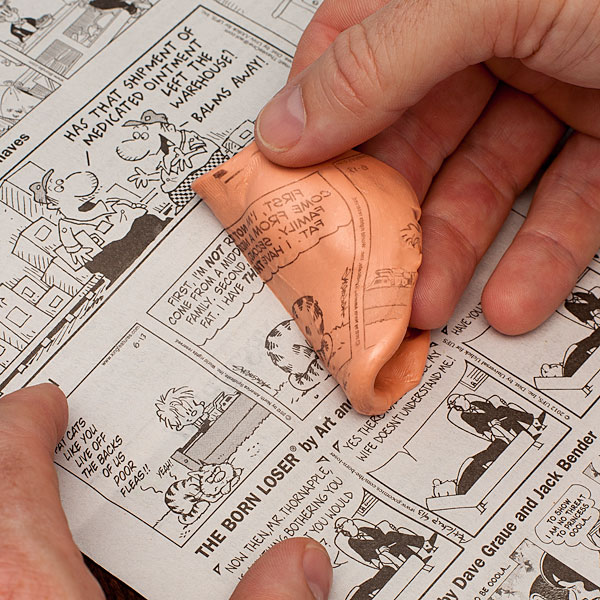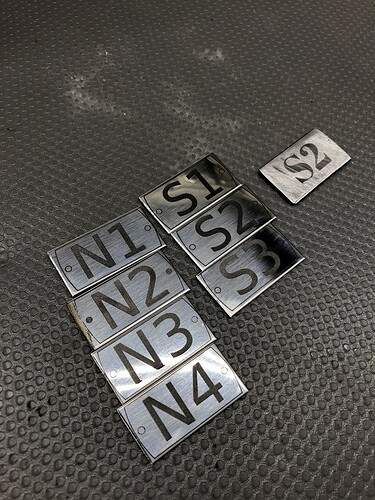makes one wonder if you could transfer comic strips from the newspaper to stainless using this technique…
Anyone consider trying mineral oil on a paper towel? If the acidity isn’t necessary, and the water evaporates quickly, perhaps this would work? I have no idea, just pondering while waiting on my shipping notice!
What childhood?..We do that every year at Christmas time. (Adults too.)
Silly Putty is a great stocking stuffer. 
The professionally marked logos on my frothing pitchers (yeah, I’m a coffee snob) have faded considerably with repeated washing, so I’m not surprised that this technique fades a bit when washed. However, it should be perfect for items that would rarely be washed.
My mind just went into “idea mode.”
This is ridiculously cool and surprising. Great news!
Me too!
This is a cool discovery! Thanks for posting your results.
This answers a question from a friend. “Could I etch a floor plan?” I had said no, but happy to now be wrong. Every day I read the new threads and my wait for Glowgon becomes increasingly difficult.
This really has me curious, so I asked a couple of people with chemistry backgrounds to speculate on the cause.
Their thoughts:
- The water is likely just to hold the biomass (aka paper towel) in place and close to the metal.
- The laser could be forcing the salt in the biomass to result in a directed rust.
- The laser could be combining the biomass with the metal to form an oxidizing agent. The black line might even be magnetite (Fe304). (This sounded like the better explanation to me, but I’m not a chemist.)
Today or tomorrow, I’ll give it a try.
Assuming that it is salt, then salt water on a paper towel should work better.
If the water is only there to keep the biomass close to the metal, then kleenex might be better than a paper towel. (My thinking: thinner = closer.)
If it’s really just a need for biomass, then a thin layer of dried mustard (or Brother Mel’s BBQ sauce) will probably be the best option. By removing the water (waiting an hour for the mustard to dry), we might get a cleaner line since there isn’t water to do any refraction.
Then again, maybe dried Elmers glue will work. Dries fast, easy to remove, dries thin, and has biomass.
I can’t wait to play!
If only someone would try pepper ?
Then we could write it up as “Salt,Mustard,Vinegar,Pepper”.
and just skip the rest.

I googled “what else can we try to mark stainless steel with a laser?”
For Science!
I <3 you guys.
Went looking and found this
https://www.evilmadscientist.com/2013/laser-moly/
Reading down through the comments, I was pleased to see a thought that I have posted here somewhere about using pottery type glaze material, then using the laser to fuse it.
Lots to try in the future, if my head doesn’t explode soon !

If paper + water is part of the formula, maybe paper masking tape like we use on wood could work. The top paper layer could get pretty soggy before the adhesive failed. Of course the adhesive is an additional barrier between the water and the metal.
Also, in the plaster article, someone posted this comment:
I have done some fine markings with my 60watt laser on any metal using cheap galvanizing spray in a can . It sits real well on the surface and does not buff off at all . work like a charm
Just tried doing a spoon (several times) w/o leaving a mark using white vinegar and the settings OP described. Changing focus height didn’t change outcome. Using GF pro, so I have the more powerful laser.
I also tried a kitchen knife (big flat surface) using same settings, and I only go the very faintest of discoloration. I’m going to say that this idea is interesting, but more experimentation is needed before we call this a solved problem.
I did these stainless steel tags with some settings I picked up elsewhere on the forum. I think it was full pews and 300 zooms.
You can see a previous attempt in the background. I used a layer of dry moly lube on the surface of the SS. The difference between the first attempt and the much better, bold attempts in the foreground was that I had a perfect mirror finish on the ones that turned out nice. My assumption was that the stainless gets turned into a rough surface and oxidizes, so the better contrast will come with the polished surface surrounding the engrave.
Also, since the engrave only takes a few molecules deep out of the surface of the stainless, then if you have any scratches (like my first S2 attempt) the stretches are way deeper than the engrave.
It would take some experimentation and possibly destructive testing to see what any flavor of silverware is actually made from and if it had an electroplated coating.
If it is an older tableware set it will be plated. A variety of steel, chrome, nickel (basis for stainless), and silver covering was the norm, with expensive sterling silver if high quality.
New trend does seem to be stainless minus the silver, but even stainless by itself has many many flavors of varying quality. If non-magnetic, then it used nickel, and even that test is iffy depending on the alloy.
What you did is one way to test. Just giving it a go is probably the fastest approach.
But, just like not all wood or plastic is the same, neither is stainless, especially when delivered as a finished product.
Heck…
Now we can clearly
engrave Rocks, Papers, and Scissors!
After experimenting with mild steel (almost nothing) and brass (even closer to nothing) I tried tool steel and got similar results to stainless.
I am assuming it is the carbon content of the metal that gives a good result.

